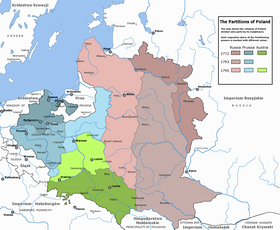Partitions of Poland
The Partitions of Poland or Partitions of the Polish-Lithuanian Commonwealth is a term used in history. They took place in the second half of the 18th century and ended the existence of the Polish-Lithuanian Commonwealth.[1][2][3] Three partitions of the Polish-Lithuanian Commonwealth took place:
- 5 August 1772
- 23 January 1793
- 24 October 1795
| Partitions of Poland | |
|---|---|
 The Polish–Lithuanian Commonwealth in 1772 | |
| Elimination | |
 The three partitions of Poland (the Polish–Lithuanian Commonwealth). The Russian Partition (brownish/reddish), the Austrian Partition (green), and the Prussian Partition (blue) |
The partitions were carried out by Prussia, Russia and Habsburg Austria dividing up the Commonwealth lands among themselves.
The less often used term "Fourth Partition of Poland" may refer to any later division of Polish lands, specifically:
- After the Napoleonic Era, the 1815 division of the Duchy of Warsaw at the Congress of Vienna;
- The 1832 incorporation of the "Congress Kingdom" into Russia, and the 1846 incorporation of the Republic of Kraków into Austria; and
- The 1939 division of Poland between Germany and the Soviet Union after the Molotov-Ribbentrop Pact.[4]
History change
Prelude change
Poland-Lithuania in its final period (mid-18th century), before the partitions was already not a completely sovereign state. It was almost a vassal, or a Russian satellite state, with Russian tsars effectively choosing Polish kings. This applies particularly to the last Commonwealth King Stanisław August Poniatowski, who for some time had been a lover of Russian Empress Catherine the Great.
In 1730 Commonwealth's neighbours, namely Prussia, Austria and Russia, signed a secret agreement in order to maintain the status quo: specifically, to ensure that the Commonwealth laws would not change. Their alliance later became known in Poland as the "Alliance of the Three Black Eagles" (or Löwenwolde's Treaty), because all three states used a black eagle as a state symbol (in contrast to the white eagle, a symbol of Poland).
The Commonwealth had remained neutral in the Seven Years' War, though sympathizing with the alliance of France, Austria, and Russia. It allowed Russian troops access to its western lands as bases against Prussia. Frederick II of Prussia retaliated by ordering Polish currency counterfeited to affect the Polish economy.
The Poles tried to expel foreign forces in an uprising (the Confederation of Bar, 1768–1772), but the irregular and poorly commanded forces had litte chance in the face of the regular Russian army and suffered a defeat. Adding to the chaos was a Ukrainian peasant rebellion, the Koliyivschyna, which erupted in 1768 and resulted in massacres of noblemen (szlachta), Jews, Uniates, and Catholic priests before it was put down by Polish and Russian troops.
References change
- ↑ Rbert Bideleux, Ian Jeffries. A History of Eastern Europe: Crisis and Change. Routledge:1998 p.156
- ↑ Judy Batt, Kataryna Wolczuk.Region, State and Identity in Central and Eastern Europe.Routledge:2002,p.153
- ↑ Nancy Sinkoff.Out of the Shtetl: Making Jews Modern in the Polish Borderlands.Society of Biblical Literature:2004, p.271
- ↑ Brecher, Michael & Wilkenfeld, Jonathan (1997). A Study of Crisis. University of Michigan Press. p. 255. ISBN 978-0-472-10806-0.
{{cite book}}: CS1 maint: multiple names: authors list (link)